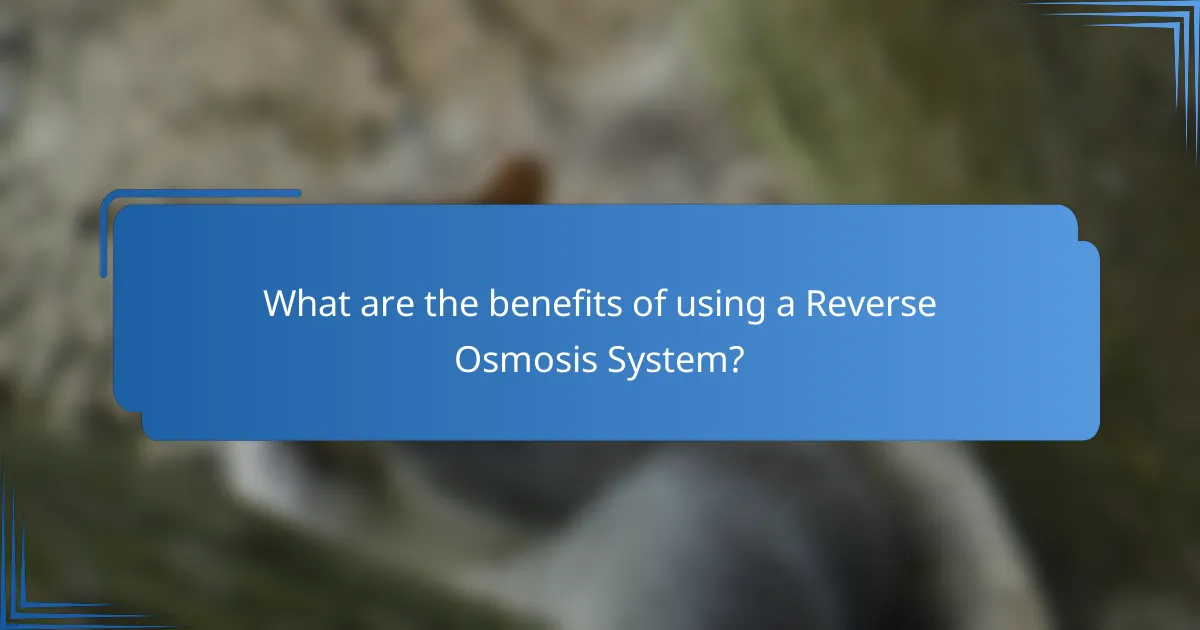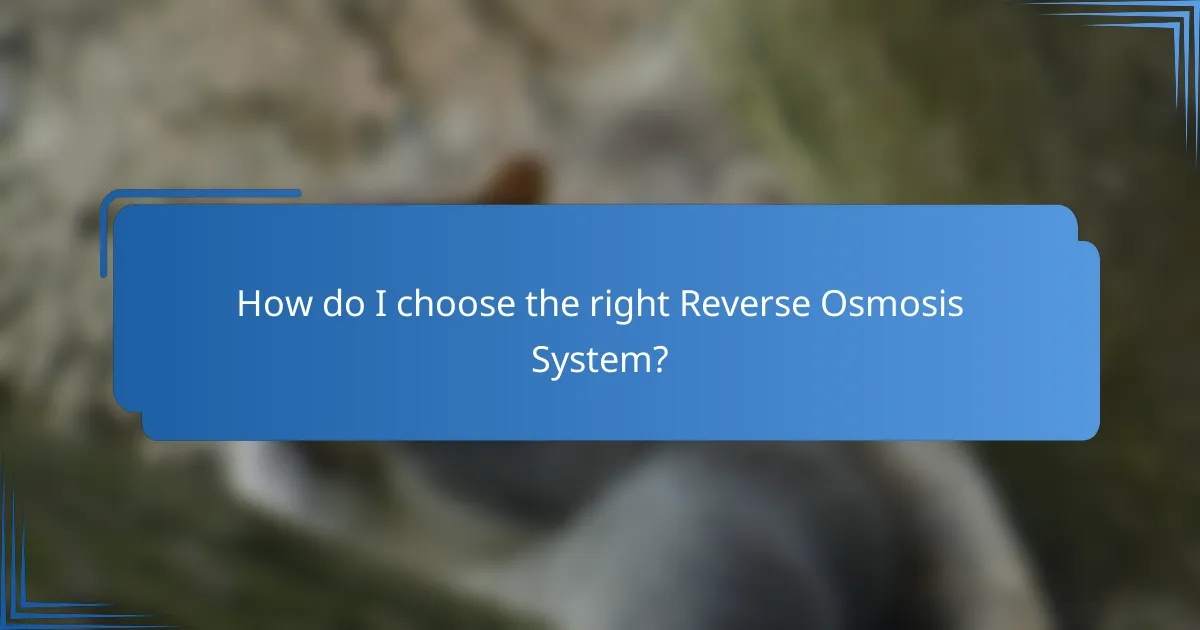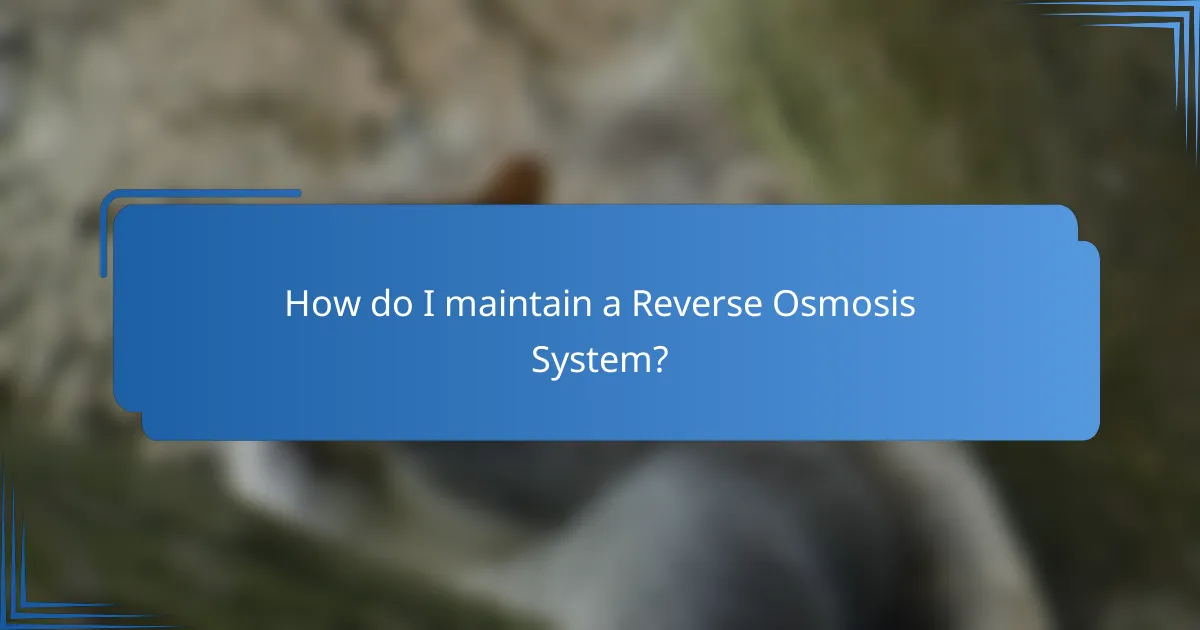A reverse osmosis system is an effective solution for purifying drinking water by utilizing a semi-permeable membrane that filters out contaminants and impurities. This technology not only enhances the taste of water but also contributes to reducing environmental waste, making it a smart choice for households seeking cleaner and safer drinking water.

How does a Reverse Osmosis System remove contaminants?
A reverse osmosis system removes contaminants from water by using a semi-permeable membrane that allows only water molecules to pass through while blocking larger particles, including impurities and contaminants. This process effectively purifies drinking water, improving its taste and safety for consumption.
Membrane filtration process
The membrane filtration process in reverse osmosis involves pushing water through a semi-permeable membrane under pressure. This membrane has tiny pores that allow water molecules to pass while rejecting larger molecules, such as salts, bacteria, and other impurities. The result is cleaner, safer water that is free from many harmful substances.
Typically, the pressure required for this process can range from 40 to 100 psi, depending on the system and the quality of the source water. Higher pressure can enhance the filtration efficiency, but it may also increase energy consumption.
Common contaminants targeted
Reverse osmosis systems effectively target a variety of common contaminants found in drinking water. These include chlorine, lead, nitrates, and various dissolved solids. By removing these substances, the system significantly improves the quality of water for drinking and cooking.
In addition to chemical contaminants, reverse osmosis can also reduce microorganisms, such as bacteria and viruses, making the water safer for consumption. This is particularly beneficial in areas where water quality is a concern.
Effectiveness against heavy metals
Reverse osmosis is highly effective against heavy metals, such as arsenic, cadmium, and mercury. These metals can pose serious health risks, and the reverse osmosis process can remove up to 95% or more of these contaminants from water. This makes it a reliable choice for households concerned about heavy metal exposure.
Testing the water before and after installation can help determine the specific effectiveness of the system against heavy metals present in your supply. Regular maintenance of the system is also essential to ensure optimal performance.
Reduction of chlorine and fluoride
Reverse osmosis systems are particularly effective at reducing chlorine and fluoride levels in drinking water. Chlorine, commonly used as a disinfectant in municipal water supplies, can affect taste and odor. RO systems can remove over 90% of chlorine, improving the overall quality of the water.
Fluoride, while beneficial for dental health in small amounts, can be a concern for some individuals. Reverse osmosis can reduce fluoride levels by approximately 70% to 90%, making it a suitable option for those looking to limit their fluoride intake.

What are the benefits of using a Reverse Osmosis System?
A Reverse Osmosis System offers several advantages, including the removal of contaminants, improved taste of water, and reduced environmental waste. These systems effectively filter out impurities, making drinking water safer and more enjoyable.
Improved taste of drinking water
One of the primary benefits of a Reverse Osmosis System is the enhanced taste of drinking water. By removing chlorine, heavy metals, and other impurities, the water becomes cleaner and more refreshing. Many users report a noticeable difference in flavor, making it more appealing for everyday consumption.
Additionally, the system can eliminate unpleasant odors and tastes associated with tap water, such as those from old pipes or municipal treatments. This improvement can encourage more water consumption, promoting better hydration.
Health benefits of purified water
Using a Reverse Osmosis System can lead to significant health benefits by providing purified water free from harmful contaminants. This includes the removal of bacteria, viruses, and chemicals that may pose health risks. Drinking clean water can support overall well-being and reduce the likelihood of gastrointestinal issues.
Moreover, the absence of heavy metals like lead and mercury can help prevent long-term health complications. For families with young children or individuals with compromised immune systems, having access to purified water is particularly crucial.
Environmental impact reduction
Reverse Osmosis Systems contribute to environmental sustainability by reducing reliance on bottled water. By providing high-quality drinking water at home, these systems can help decrease plastic waste significantly. This shift not only conserves resources but also minimizes pollution associated with plastic production and disposal.
Furthermore, many systems are designed to use water efficiently, minimizing waste during the filtration process. Users can expect to waste a fraction of the water compared to older filtration methods, making it a more eco-friendly choice.

How do I choose the right Reverse Osmosis System?
Choosing the right reverse osmosis system involves assessing your water quality, household size, and specific filtration needs. Look for systems that effectively remove contaminants while improving taste and minimizing water waste.
Key features to consider
When selecting a reverse osmosis system, consider the filtration stages it offers. Most systems include multiple stages, such as pre-filters, RO membranes, and post-filters, which enhance contaminant removal and improve taste. Additionally, check for certifications like NSF/ANSI standards, which ensure the system meets safety and performance benchmarks.
Another important feature is the system’s water production rate, typically measured in gallons per day (GPD). Higher GPD ratings are beneficial for larger households or heavy usage. Also, consider the tank size; a larger tank can store more filtered water, reducing wait times for access.
Top brands in the market
Several brands are well-regarded in the reverse osmosis market. APEC, iSpring, and Home Master are known for their reliability and performance. APEC systems often feature high-quality components and user-friendly designs, while iSpring offers a range of budget-friendly options without sacrificing quality.
Home Master is praised for its innovative designs, such as the modular filter system that simplifies maintenance. Researching customer reviews and expert ratings can help you identify the best fit for your needs.
Price range and budget options
The price of reverse osmosis systems can vary widely, typically ranging from around $150 to $600 or more. Entry-level systems may suffice for basic needs, while higher-end models offer advanced features and greater efficiency. Consider your budget and how much you are willing to invest in long-term water quality.
Additionally, factor in the cost of replacement filters and maintenance. Some systems require more frequent filter changes, which can add to the overall expense. Look for systems with affordable replacement parts to keep ongoing costs manageable.

What is the installation process for a Reverse Osmosis System?
The installation process for a reverse osmosis system typically involves several key steps to ensure proper setup and functionality. This system effectively removes contaminants from water, improves taste, and reduces waste, making it essential to follow the installation guidelines carefully.
Step-by-step installation guide
Begin by selecting an appropriate location for the reverse osmosis system, ideally under the kitchen sink. Shut off the water supply and drain the faucet to prevent leaks during installation. Next, install the faucet that comes with the system, ensuring it is securely mounted.
Connect the water supply line to the system, followed by the drain line, which directs wastewater away. Finally, attach the storage tank and check all connections for leaks before turning the water supply back on.
Tools required for installation
To install a reverse osmosis system, you will need a few essential tools. A wrench or pliers will help tighten fittings, while a drill may be necessary for creating holes for the faucet. Additionally, a bucket can be useful for catching any water during the installation process.
Having a level and measuring tape on hand can ensure that the system is installed correctly and aligned properly. It’s also advisable to have a towel or sponge ready for any spills.
Common installation challenges
One common challenge during installation is dealing with limited space under the sink, which can make it difficult to maneuver the system components. If space is tight, consider removing any unnecessary items to create room.
Another issue may arise from incorrect connections, leading to leaks. Double-check all fittings and connections, and use plumber’s tape to ensure a tight seal. If you encounter persistent leaks, consult the installation manual or seek professional assistance.

How do I maintain a Reverse Osmosis System?
Maintaining a reverse osmosis system is essential for ensuring optimal performance and water quality. Regular upkeep involves timely filter replacements, thorough cleaning, and monitoring for any signs of malfunction.
Regular filter replacement schedule
To keep your reverse osmosis system functioning effectively, adhere to a regular filter replacement schedule. Typically, pre-filters should be replaced every 6 to 12 months, while the RO membrane may last 2 to 3 years, depending on water quality and usage.
Check your system’s manual for specific recommendations, as some models may have different requirements. Keeping a calendar or reminder can help you stay on track with these replacements.
Cleaning and sanitizing procedures
Cleaning and sanitizing your reverse osmosis system is crucial for preventing bacterial growth and maintaining water quality. A common practice is to sanitize the system every 6 months by using a food-grade hydrogen peroxide solution.
Follow the manufacturer’s instructions for the cleaning process, ensuring that all components are thoroughly rinsed after sanitization. This will help maintain the efficiency of the system and prolong its lifespan.
Signs of system malfunction
Be vigilant for signs of malfunction in your reverse osmosis system, such as a decrease in water pressure, unusual noises, or a change in water taste or odor. These issues may indicate clogged filters or a failing membrane.
If you notice any of these symptoms, it is advisable to inspect the system promptly. Addressing problems early can prevent costly repairs and ensure that your water remains safe and pleasant to drink.
